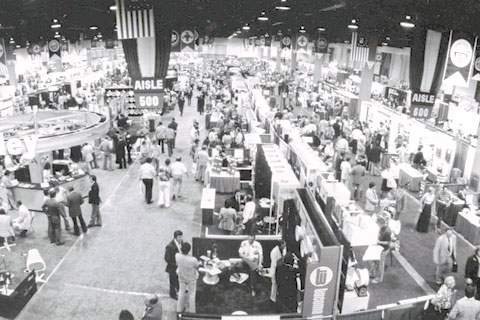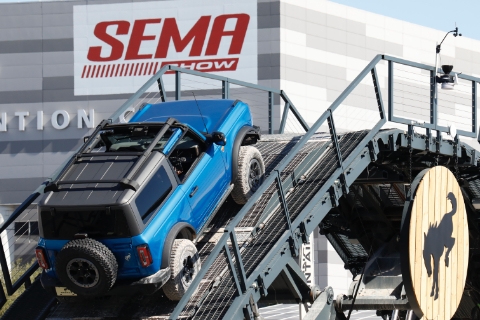SEMA News—July 2015
A Few Words With Doug Evans
An Interview With the Incoming Chairman of SEMA’s Board of Directors
| |  Doug Evans has worked directly with companies ranging from small manufacturers and WDs to Fortune 500s on everything from product design and testing to supply chain recommendations, as well as national and local retail promotions with consumers. He was SEMA Person of the Year in 2009 and has served on the Show Committee, Hall of Fame Committee, and was SBN Mentor of the Year in 2012 and inducted into the ARMO Hall of Fame in 2010. |
On Friday, July 24, SEMA will host its annual Installation Gala. At that event, SEMA Board Chairman Nate Shelton will pass the leadership torch to SEMA’s new chairman, Doug Evans. Evans has more than 30 years experience in the industry and a long history of service on behalf of the association, including three prior terms on the Board of Directors. SEMA News recently interviewed Evans about his perspectives, goals and priorities as chairman.
SEMA News: You bring a long history of service to the industry, having served three terms on the Board of Directors (BOD) as well as numerous committees, and you received a number of special recognitions, including Person of the Year. Looking back on your years of service, what led you to get involved with SEMA in the first place, and what would you say to younger people who might ask about the experience?
Doug Evans: My involvement with SEMA has given me back 10 times what I have put into it. It has provided me—and continues to provide me—an opportunity to make a real difference in people’s lives. Anyone reading these words is lucky enough to work in an industry like no other. That saying, “When you love what you do, you never work another day in your life,” it’s so true. All of us need to spread that word and give back however we can. For me, that has been SEMA. I would encourage anyone to get involved. It is a fantastic experience.
SN: Since you began serving on the BOD, you’ve advocated programs to help young people enter the industry. Now that you are chairman, what do you hope to accomplish on this issue? What kind of priority should it receive?
DE: Youth engagement, education and training are high on my list. We have already begun putting a long-term plan together that will provide for real outreach to young people across the country. We will be working to put shop classes back into high schools and connect junior colleges to high schools in their areas to get kids back in the shop and off the couch. We hope to roll out a high-school drag-racing program nationally and have our young people be our ambassadors to get other kids involved and keep it safe. We are planning career days for schools in the areas where we have town hall meetings. We are also working to help member companies provide real internships and early training to groom the next generation of people who will be SEMA members.
SN: What are you hearing from colleagues and fellow SEMA members about their balance sheets for the first six months of 2015?
DE: From what I am hearing, member companies almost across the board are having a great year. It is very encouraging!
SN: With the 2015 SEMA Show roughly three months away, what should SEMA members take advantage of today in order to get the best return on their investment?
DE: If they are like me, I start building my calendar now and making decisions about how much of my staff goes and when. Managing time and expenses are two big keys to having a great show, in my view.
SN: As you well know from your service as chairman of the SEMA Political Action Committee (SEMA PAC), the association maintains an office in Washington, D.C., to advocate on behalf of the automotive specialty-equipment industry on legislative and regulatory issues. Can you share your perspective on current legislative/regulatory issues that might be on your radar at the moment?
DE: Thanks for asking. I have been the chairman of the Political Action Committee (SEMA PAC) for about 10 years now. There has never been a more important time for people to be a part of our PAC. Things in Washington, D.C., are always changing. We can’t afford to be stuck in neutral and let others take control of our future. SEMA PAC helps us keep pace by supporting the car guys in Congress that have our industry’s back. The more people that sign up to receive information about the PAC, the stronger we are. Over the years, I have had a unique vantage point to witness many dangerous pieces of legislation floated that would be disastrous to our industry. These are often simply unintended consequences from a proposed law or regulation that could cause immeasurable harm. The PAC fights back by supporting lawmakers who are friends to small business and our industry. This, combined with the stellar efforts of our staff in Washington, D.C., dramatically limits our exposure to negative forces.
On the emissions front, SEMA continues to untangle the variety of state and federal requirements. Working with the California Air Resources Board, we have put together a streamlined path for achieving emissions compliance. Companies really need to understand the consequences of non-compliance and the ways that SEMA is here to help. We also have a possible fight regarding the potential closure of a huge swath of land out West that could end off-road activities at Moab. This action would dramatically impact thousands of off-road enthusiasts and the companies that sell them parts. These issues and more result in a constant fight, so I would encourage everyone to take an interest and get involved. Call the D.C. office today at 202-783-6007 for PAC info or go online to www.semapac.com.
SN: The manufacturing world is evolving daily as rapid prototyping and 3D printing technologies advance at a dizzying pace. What are your thoughts about how to help member companies keep up with these new technological advancements?
DE: For a start, take advantage of the SEMA Garage at the association’s headquarters in Diamond Bar, California. It has a dedicated staff and state-of-the-art equipment to complete rapid prototyping on the spot. Companies should also take advantage of our Tech Transfer data from the OEMs. In many cases, SEMA has advance vehicle data on file, saving companies the time and expense of having to reverse-engineer newer vehicles.
SN: The SEMA Data Co-op (SDC) is a project that you have been involved with since the early planning stages. In its first few years, the SDC has built a database that includes more than 4 million part numbers and nearly 1,000 members. Where do you see the SDC in the next five years, and what effect will it have on the industry?
DE: The SDC is a staggering project that so many great people have been working on now for years. It dates back a decade, when it became clear that the industry needed a common language for companies, wholesalers and consumers to be able to talk to each other easily. Parts attribution data in a common language for all member companies is incredibly important, and when complete, it will save people thousands of hours through a more streamlined inventory system and fewer returns. It is truly the 800-lb. gorilla in the room, but I am proud of the SEMA staff that is working on it with great volunteers such as Tim Martin and Bob Moore. They are making great headway!
 “Youth engagement, education and training are high on my [priority] list. We have already begun putting a long-term plan together that will provide for real outreach to young people across the country.” | |
SN: Now that you are chairman of the SEMA BOD, have your priorities evolved in comparison to the last two years when you were serving as chair-elect? What do you see as the association’s top priorities over the next 12 months?
DE: Yes, priorities evolve daily. For example, this year is going to be the first year where we are plateauing on space and revenue from the SEMA Show. This makes it even more important to be careful stewards of finances for operating everything we do. We will need to carefully prioritize what projects we take on and make sure that members are receiving a healthy return on that investment of resources. We also have several new legislative and regulatory issues on the horizon that will take priority. Finally, with each passing year, advanced vehicle technology is a bigger and bigger challenge for members that manufacture parts for newer cars and trucks. We need to stay ahead of this in a big way.
SN: SEMA has organized several trips for members to explore international business opportunities, particularly in the Middle East and China. As chairman, what do you see on the horizon with respect to SEMA’s international programs?
DE: Vehicles being produced today by our OEMs are now very much global in nature. This makes for significant opportunities for companies looking to tap new markets. I would encourage companies that are interested to reach out to Linda Spencer [lindas@sema.org] and find out how to participate. Companies are making connections and money by going on these trips!
SN: Connecting with consumers has been a Board-level strategic initiative for the last five years. What is your opinion of SEMA’s progress in this area, and where do you see additional opportunities for consumer outreach?
DE: This has been an initiative since the ’60s, I think! SEMA has made great progress in this area with SEMA Ignited and Battle of the Builders. For readers who don’t know, SEMA Ignited is a consumer event that we rolled out at the 2014 SEMA Show. It began at an off-site venue when the show closed on Friday. Within the Show, the first-ever winner of the Battle of the Builders was crowned. This was a competition among the best of the best builders with vehicles on display in the Show. All of this was filmed and aired multiple times on Velocity. We will be doing it again in 2015. We have also been discussing adding an element to our youth engagement efforts that involves sending emissaries and vehicles out to schools and events outside our own industry to show people what we are about and what we have to offer for careers and as a hobby.
SN: Anything else you’d like to add?
DE: Just to thank the membership for putting their faith in me, our Board of Directors, our councils and the staff. Those who have served on the Board or on the councils know that it is a lot of work, but it is extremely rewarding. It is my honor and privilege to contribute in whatever small way I can to an industry that has been so great to me and to the many wonderful people I get to work with every
day.








